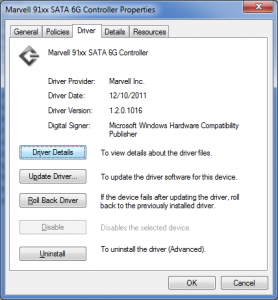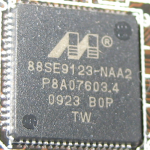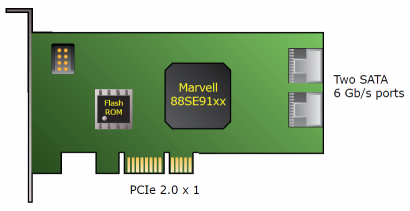Part 2 of my SSD SATA III performance tests.
If you are here and haven’t seen part 1 “Sata 3 SSD running on onboard SATA II benchmark” go here >>>
The Question
Is there any reason to buy a SATA III expansion card to run your new SATA III SSD if your MOBO only has SATA II?
So I have a shiny new Corsair Force GT 120GB SATA III drive and an old SATA II motherboard.
Last article I benchmarked the performance to see what kind of experience you get when running on your onboard sata II connectors.
This article is the part 2 where I am going to benchmark the relative performance with a SATA III expansion card to see if there is any point is spending the money on one.
The Test Card – ASUS U3S6
It was a bit hard to track one down in Australia so I had to buy this second-hand off the overclockers australia forums, but I wanted this card for its x4 PCI-e v2.0 connection.
Details of the U3S6 here.
The U3 = USB 3.0 with a NEC chip set; and
The S6 = Sata III 6.0Gb/s Marvel 88SE9123 controller.
The card has yet to be flashed from its original bios which appears as 1.0.0.1012.
I decided to play it safe and rather than flash the bios and destroy the card I would start from scratch, benchmark it first. Later I will play and see if I can improve on stock performance results, buy flashing to later versions of the firmware.
At on OS software level I tested with 2 driver configurations:
| 1.0.0.1036 | and | 1.2.0.1016 |
 |

|
with some interesting results..
The latest drivers are best found on station-drivers. It’s french but version numbers can be read easily, go to the bottom for the MV91xx drivers and firmware.
The test rig
| Mother Board: | Socket 775, Gigabyte EP45-DS3 |
| CPU: | Core 2 Duo E8400 3.0Ghz, running overclocked @ 4.0Ghz. |
| Memory: | 4GB (2x2GB) Corsair CM2X2048-8500C5C (1066Mhz) |
| Video: | MSi R6850 Storm II 1G OC (R6850 PM2DIGD5) |
| SSD: | Corsair Force GT 120GB, (1.3.3 firmware on SATA II in AHCI mode) |
| SATA III Card | Asus U3S6 (firware 1012) |
| OS: | Windows 7 SP1 – 64 bit |
The U3S6 is a x4 card and will run on PCI-E v2.0. The EP45-DS3 only has 3 x PCI-e 1.0 x1 ports, and has a x16 and x8 PCI-e v2.0 slot.
The x16 slot is currently running my MSi HD 6850, and the x8 slot is free.
The U3S6 is therefore running in the x8 slot.
I was interested in seeing what might happen when running something like crysis whilst having the U3S6 trying to use the same bus.
Synthetic Benchmarks
AS SSD
My original SATA II Benchmark score on SATA II was 480! I did this benchmark on day 1 of a clean Windows 7 install. Since then I have been using the computer for a few months and the drive is about 50% full so I benchmarked with AS SSD again.
I did numerous benchmarks with in multiple different driver and SATA configurations. The Read speed seemed to give consistent results across similar benchmarks but the write performance (particularly the 4K-64-Thrd) was a bit all over the place and seemed to influence heavily the overall score giving results between 395 and 450.
The following results are the best of each run:
The U3S6 seems to have better sequential read of approx 340MB/s. This is only a 75MB/s improvement.
I noted that generally the benchmark results for the earlier 1.0.0.1036 driver were slightly better and more consistent than the later 1.2.0.1016 driver.
Also the Read performance was generally consistent but the 4k and 4k-64Thrd write times were up and down.
Crystal Disk mark
Given the fluctuations I also tried Crystal Disk mark which seemed to give similar results without the randomness.
Again the 1.0.0.1036 driver seemed to out perform its older brother.
Windows Start Up Times
The test
Same as last time, the benchmark recorded the time from when windows started loading after the POST screen, until a working desktop was available. This was identified as the time at which the Gadgets appeared on the desktop. This was split into 3 timing points
- time to login screen
- time to login
- time to see the desktop and the gadgets loaded.

The fastest startup time was still SATA II and the 1.2.0.1016 driver made a difference but the 1.0.1036 was consistently a few seconds slower to boot.
Windows Experience
The only score to change when running the U3S6 was the Disk from 7.8 to 7.9. Note: 7.9 is currently the maximum rating.

Crysis Benchmarks
I didn’t bother with the load time tests as I figured they would be comparable.
I did however run the Benchmarks for both Crysis and Crysis 2 in the various configurations, with some interesting results.
Crysis Benchmark
The crysis benchmark was run @ 1920×1080 – 64-bit and DirectX 10
The benchmark was run with the following SSD connections
- SATA II
- U3S6 1.0.0.1036
The results were almost identical. No change here.
Crysis 2 Benchmark
The benchmark was run on DirectX 11 on the Times Square Map.
The most interesting thing here is that when the video card was being pushed by crysis 2, the PCIe channel appears to be compromised by the SSD drive running on the x8 port.
This can be seen in the poor fps on the two higher settings.
USB Performance
Just to see how the USB 3.0 worked I hooked up my Western Digital 1 TB external hard drive and did a 4.14GB and 15.5 GB file copy both up to and down from the External drive.
I found the 15.5GB copy onto the external drive took 10m 1s @ USB 2.0 but only took 3m 52s on USB 3.0. The copy down from the external driver took 9m 11s @ USB 2.0 and 3m 43s @ USB 3.0.
The copy rates were approx 27.1 MB/s combined for USB 2.0 whilst USB 3.0 achieved 67.9 Mb/s or 2.5 times faster. Nice.
Why so slow?
I have gotten around to flashing the Card. At first it felt like “flushing” not “flashing” as the firmwares I tried off “Station-Drivers” broke the card. After a few hours of flashing I finally got the driver working with Firmware revision 1028 “Firmware pour U3S6 Rev 0 (MV-9123) Version:1.0.0.1028) Mod by Daoud333”
So when I start it up I see the following
PCIe x1 5.0Gbps. x1 why x1, its a x4 card running in a x8 slot?
After some digging I found this spec document on the controller, Marvell 88SE91xx Product Brief. If you read this the spec fo the controller shows this..
The controller only supports a single x1 connection.
I feel a bit duped. I specifically got this card for its x4 connection, but given the fact the marvel controller only accepts a x1 connection the SATA will only ever be able to run at this speed. I have read other people suggest that the x4 is used to split the channel in half and use some of the x 4 bandwidth for the USB 3.0 controller, which would make sense but it seems like false advertising to me.
Conclusion
Overall I think if you are out of SATA ports on your PC and need a few more, then the card is OK as long as you are NOT using it for gaming.
The sequential read is slightly better but this is only a benchmark figure as it did not translate in the real world.
The only other nicety is the USB 3.0 which will come in handy in the future.
I think in the next few months The Marvel 92xx controllers
will start to appear and these may allow my SSD to run to its full potential as this supports PCIe x2.
Cheers
















Nice write up mate.At least we know, was about to get the Asus add-on sata3 card too, but i guess, i’ll pass. =)
Thanks again. =)
Thanks for the rewiew.
The latest SATA driver is 1.2.0.1019. You should test it with latest driver instead of 1.2.0.1016, and firmware Version:1.0.0.1028. Appartently it gives better results.
Hi if you check out the section title “Why so slow”, you will see that I have flashed to firmware version 1.0.0.1028. I did benchmark it and saw no real performance difference. I will try the latest driver, but I won’t hold my breath. As I suggested we are constrained by the PCIe x1 connection of the marvel controller. I will test and post an update if it makes any difference
Hi. Thanks for the review, no one seems to be selling this card anymore, but it seems to be a solution I need. I’d like to install in HP’s N40L which has 2 PCI slots, x16 and x1/x4 combo. It’s my understanding that the x4 part is proprierty to HP’s setup in this case and is used for it’s remote access card. However, based on your write up this card can only run at x1 anyways due to Marvell’s controller….excuse my ignorance, but does this mean I can plug it into the x1 slot of the N40L?
No you cannot, it still needs to run in the x4 slot.
See this write up everythingusb
And specifically this image,
U3S6 x4 compared to x1
The U3S6 card is a x4 card but on the PCB (Printed Circuit Board) they split the channels. The spec on the marvell controller says it can only run @ x1 so the speed is x4 to the PCB but then drops to x1 when it hits the Marvell controller. Like water going through a pipe the flow will only be as fast as the smallest pipe allows. The Marvell controller is the smallest pipe on this card.
You look like the man to go to~
I’m looking for an add-in card for USB3 which has the connectors on the card, internally. I want to add a front panel USB3- but I can’t seem to find one that doesn’t want you to snake the cables out the back & then plug in (which seems ridiculous). Do you what I mean? Is there such a thing?
Ta!
@Tracy
I think I know what you mean.
You don’t want something like this..
http://www.amazon.com/SilverStone-FP36B-Aluminum-3-5-Inch-Converter/dp/B0049MPQCW
But I just did a few quick searches and found things like this.
http://www.espow.com/wholesale-unitek-2-port-usb-3-0-front-panel-hub-kit-with-pci-expresscard.html
These appear to be a product made by unitek, which I found a site for here.
http://www.unitek-products.com/en/product_list.php?scid=37
I can’t vouch for their performance but it seems to fit the specs for what you want.
Let me know if it works out for you.
Hi,
so whats the results of read write speed using a new Version:1.0.0.1028 bios/firmware ???
have you done some tests?
PCIe v.2 x1 theoretical maximum speed is 500MB/s, you’re nowhere near that value there is 140-150MB/s headroom!
cheers!
Hi,
Sorry you are right I have not put up any benchmarks on the 1.0.0.1028 firmware. I did do various tests with it but from memory there was really no measurable difference. I have found that the results of the benchmarking varies and taken on average there is no appreciable difference.
You are also correct that the theoretical limit on the PCIe 2.0 is 500Mb/s. For some reason I had it in my head that it was only 250Mb/s when I wrote this, hence why I was thinking it had to do with the x1 channel limiting the through put.
The benchmark results are the results, and the results don’t lie. It could be related to my motherboard running it in the 8x slot, but I have a suspicion it is related generally to the Marvell controller. The 500Mb/s is a theoretical limit, but still it is disappointing to be so far away from that limit.
I saw a similar post http://www.tomshardware.com/forum/278124-32-sata-pcie-card. This person had a different add-on card but was still only seeing 400Mb/s sequential read.
FYI, I don’t use the U3S6 in day to day usage, I use the onboard SATA II.
I noticed there is an updated driver so I might give that a go and see if my results improve.
thanks for all the useful “real world” info. I was amazed how many so called SSD “experts” web sites havent touched on the SATA II v SATA3 issue. In my mind its one of the first questions that pops up when upgrading to SSD.
You’ve just saved me the hu nt and purchase price of a PCI sata 3 card
Cheers
Great article – thank you. I was quite curious to see the SATA II vs SATA III difference with an SSD (as I just got a SATA III SSD but am running it on a SATA II motherboard)
Much appreciate the peace of mind of knowing the SATA II benchmarks (which just aren’t available anywhere) and the difference in II vs III (which isn’t a great big one)
Excellent article. This U3S6 card will be on my hands just after two days. I am also willing to put an article based on Sata-II vs Sata-III performance. My current AMD Sata-II performance aint bad at all. But still i wanted something extra if it can happen thru this Add-on card. But this is the only article on internet considered as best if anyone wants to compare a U3S6 Card with the opponent. Thanks for the write up !
Where i can download Firmware pour U3S6 Rev 0 (MV-9123) Version:1.0.0.1028) Mod by Daoud333?
I can’t seem to find it online anymore. Your best bet for updated firmware would be as per my article, station-drivers.
This page seems to be their Marvell page now – http://www.station-drivers.com/index.php?option=com_remository&Itemid=353&func=select&id=215&lang=en
Hi there, I think you made a mistake. The Asus U3S6 is only compatible with the following mother boards from Asus (and ONLY THESE ONES):
Maximus III Formula
P7P55D Deluxe
P7P55D EVO
P7P55D PRO
P7P55D
P7P55D LE
P7P55 LX
P7P55 WS Supercomputer
P6T Deluxe
P6T Deluxe V2
P6T WS Professional
P6T7 WS SuperComputer
P6TD Deluxe
P6T SE
Rampage II Extreme
Rampage II GENE
M4A79T Deluxe
M4A785TD-V EVO
M4A77TD PRO
M4A79T Deluxe/U3S6
M4A77TD PRO/U3S6
M4A785TD-V EVO/U3S6
P6T6 WS Revolution
The U3S6 won’t work correctly with any other MOBO and yours is Gigabyte. Maybe works with others but not at 100%
Regards from Ibiza.
Well it is a pci card and it has a slot and it worked, most of the time so now sure where you got your info from? A link would help?
https://www.asus.com/latin/Motherboard-Accessory/U3S6/